

Add polygon attributes to points VS join attributes by location. Joining polygon attributes to points is a pretty common geoprocessing step.
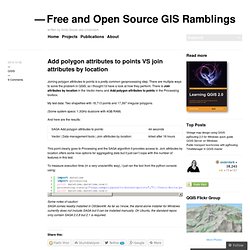
There are multiple ways to solve the problem in QGIS, so I thought I’d have a look at how they perform. There is Join attributes by location in the Vector menu and Add polygon attributes to points in the Processing toolbox. My test data: Two shapefiles with 18,713 points and 17,397 irregular polygons. (Some system specs: 1.3GHz dualcore with 4GB RAM) And here are the results: QGIS 2.0 - Point in Polygon Query. Point in Polygon Query To find out how many points in a particular layer occur in polygons of a second layer, use this method.
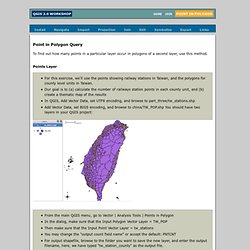
Points Layer For this exercise, we'll use the points showing railway stations in Taiwan, and the polygons for county level units in Taiwan. Our goal is to (a) calculate the number of railways station points in each county unit, and (b) create a thematic map of the results In QGIS, Add Vector Data, set UTF8 encoding, and browse to part_three/tw_stations.shp Add Vector Data, set BIG5 encoding, and browse to china/TW_POP.shp You should have two layers in your QGIS project: Checking and symbolizing results. QGIS 2.0 - CSV Import. Overview Prepare a table containing rows that include at least fields for: Unique ID, Latitude, and Longitude.
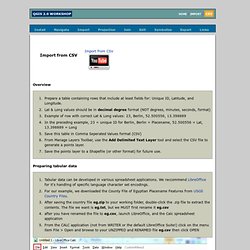
Lat & Long values should be in decimal degree format (NOT degrees, minutes, seconds, format) Example of row with correct Lat & Long values: 23, Berlin, 52.500556, 13.398889 In the preceding example, 23 = unique ID for Berlin, Berlin = Placename, 52.500556 = Lat, 13.398889 = Long Save this table in Comma Seperated Values format (CSV) From Manage Layers Toolbar, use the Add Delimited Text Layer tool and select the CSV file to generate a points layer. Save the points layer to a Shapefile (or other format) for future use. Preparing tabular data Tabular data can be developed in various spreadsheet applications. Set Character Set for your import file, USGS Country Files are UTF-8 You may also set the Language to Arabic (Egypt), but this will only affect the Libre Office view, not the subsequent import to QGIS. Using a QGIS spatial index to speed up your code · Nathan's QGIS Blog. 04 Jan 2013 If you need to do any kind of spatial operations in QGIS using Python or C++ you really want them to be as fast a possible in order reduce the amount of time you make the user wait.

Lets take the simple scenario of a recent question that was asked on gis.stackexchange; Summing up values of neighboring polygons?. I went for the SQL approach as I like how quick SQL can express what you need to do, however SQL is not the only way to skin a cat as spatialthoughts has shown in his blog post. Here Ujaval has used Python to find the neighboring polygons of each feature. Performing Spatial Joins — QGIS Tutorials and Tips. [ Download PDF A4 Letter ] Spatial Join is a classic GIS problem - transferring attributes from one layer to another based on their spatial relationship.
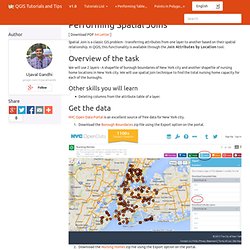
In QGIS, this functionality is available through the Join Attributes by Location tool. Overview of the task. Points in Polygon Analysis — QGIS Tutorials and Tips. [ Download PDF A4 Letter ] The power of GIS lies in analysing multiple data sources together.

Often the answer you are seeking lies in many different layers and you need to do some analysis to extract and compile this information. One such type of analysis is Points-in-Polygon. When you have a polygon layer and a point layer - and want to know how many or which of the points fall within the bounds of each polygon, you can use this method of analysis. Overview of the task Given the locations of all known significant earthquakes, we will try to find out which country has had the highest number of earthquakes.
Procedure Open and browse to the downloaded signif.txt file. Since this is a tab-delimited file, choose Tab as the File format. Note. QGIS 2.0 - Spatial Join. Spatial Join A common GIS task is to join the attributes from one spatial data layer to another.
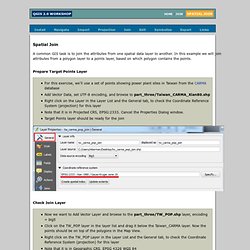
In this example we will join attributes from a polygon layer to a points layer, based on which polygon contains the points. Prepare Target Points Layer For this exercise, we'll use a set of points showing power plant sites in Taiwan from the CARMA database Add Vector Data, set UTF-8 encoding, and browse to part_three/Taiwan_CARMA_Xian80.shp Right click on the Layer in the Layer List and the General tab, to check the Coordinate Reference System (projection) for this layer Note that it is in Projected CRS, EPSG:2333.
Cancel the Properties Dialog window. TypeBrewer. Colorbrewer: Color Advice for Maps. Overlays - Google Maps JavaScript API v3. You can add objects to the map to designate points, lines, areas, or collections of objects.
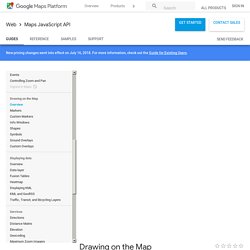
The Maps JavaScript API calls these objects overlays. Overlays are tied to latitude/longitude coordinates, so they move when you drag or zoom the map. New Zealand Latitude and Longitude Map. Roads and Addresses. This table allows the application to check for invalid combinations of TLA, Electorate, Maori & 260 sheet references at the time of data entry.
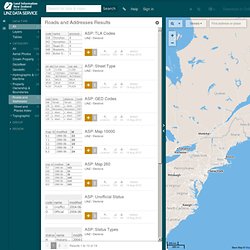
This table is recreated every time a new set of electoral boundaries takes effect, and is subsequently updated if new valid combinations are discovered. This table is part of the Authoritative Streets and Places (ASP) Database. For more information about the database including the data model see here. Notes: